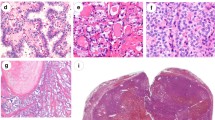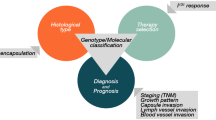Abstract
Retinoid receptors (RRs) play a key role in cell proliferation and differentiation. We characterized the expression of RA receptors and retinoid X receptors (RARs and RXRs) in a series of 111 thyroid tumors and investigated the mechanisms responsible for their deregulation: hypermethylation of the RARB2 promoter, loss of heterozygosity (LOH) in the regions of RARB and RXRA, and altered expression of CRBP1 and enzymes involved in RA biosynthesis (RDH10 and RALDH2). Expression of RALDH2 and RDH10 was conserved in 100 % of adenomas and in 90 and 98 %, respectively, of carcinomas, whereas staining for CRBP1 was decreased in 9 % of FAs and 28 % of carcinomas, mainly anaplastic carcinomas (55 %). We found an abnormal expression of RARA, RARB, RXRA, and RXRB in 67, 69, 66, and 73 %, respectively, of thyroid carcinomas (n = 78) and in 9, 9, 9, and 33 % of follicular adenomas (n = 33) (p < 0.001). An abnormal staining pattern of at least two of these markers had 90 % sensitivity and 91 % specificity for a diagnosis of malignancy. Promoter hypermethylation of RARB2 was observed in some anaplastic carcinomas (14 %). LOH was found to be common at the RARB locus (3p24–3p25) and the RXRA locus (9q34), respectively, in 44 and 55 % of carcinomas and in 27 and 43 % of adenomas. In conclusion, immunohistochemical staining for RARs and RXRs may help in the differential diagnosis between well-differentiated carcinoma and follicular adenoma. Further investigation should be carried out to determine whether the characterization of RR expression might identify patients who could benefit from therapy with RA derivatives.




Similar content being viewed by others
References
Kastner P, Mark M, Chambon P (1995) Nonsteroid nuclear receptors: what are genetic studies telling us about their role in real life? Cell 83:859–869
Mangelsdorf DJ, Thummel C, Beato M, Herrlich P, Schutz G, Umesono K, Blumberg B, Kastner P, Mark M, Chambon P, Evans RM (1995) The nuclear receptor superfamily: the second decade. Cell 83:835–839
Coelho SM, Vaisman M, Carvalho DP (2005) Tumour re-differentiation effect of retinoic acid: a novel therapeutic approach for advanced thyroid cancer. Curr Pharm Des 11:2525–2531
Fernandez CA, Puig-Domingo M, Lomena F, Estorch M, Camacho Marti V, Bittini AL, Marazuela M, Santamaria J, Castro J, Martinez de Icaya P, Moraga I, Martin T, Megia A, Porta M, Mauricio D, Halperin I (2009) Effectiveness of retinoic acid treatment for redifferentiation of thyroid cancer in relation to recovery of radioiodine uptake. J Endocrinol Invest 32:228–233.
Zhang Y, Jia S, Liu Y, Li B, Wang Z, Lu H, Zhu C (2007) A clinical study of all-trans-retinoid-induced differentiation therapy of advanced thyroid cancer. Nucl Med Commun 28:251–255
Simon D, Korber C, Krausch M, Segering J, Groth P, Gorges R, Grunwald F, Muller-Gartner HW, Schmutzler C, Kohrle J, Roher HD, Reiners C (2002) Clinical impact of retinoids in redifferentiation therapy of advanced thyroid cancer: final results of a pilot study. Eur J Nucl Med Mol Imaging 29:775–782. doi:10.1007/s00259-001-0737-6
Zhang XK, Liu Y, Lee MO, Pfahl M (1994) A specific defect in the retinoic acid response associated with human lung cancer cell lines. Cancer Res 54:5663–5669
Schmutzler C, Hoang-Vu C, Ruger B, Kohrle J (2004) Human thyroid carcinoma cell lines show different retinoic acid receptor repertoires and retinoid responses. Eur J Endocrinol 150:547–556
Haugen BR, Larson LL, Pugazhenthi U, Hays WR, Klopper JP, Kramer CA, Sharma V (2004) Retinoic acid and retinoid X receptors are differentially expressed in thyroid cancer and thyroid carcinoma cell lines and predict response to treatment with retinoids. J Clin Endocrinol Metab 89:272–280
Cras A, Darsin-Bettinger D, Balitrand N, Cassinat B, Soulie A, Toubert ME, Delva L, Chomienne C (2007) Epigenetic patterns of the retinoic acid receptor beta2 promoter in retinoic acid-resistant thyroid cancer cells. Oncogene 26:4018–4024. doi:10.1038/sj.onc.1210178
Elisei R, Vivaldi A, Agate L, Ciampi R, Molinaro E, Piampiani P, Romei C, Faviana P, Basolo F, Miccoli P, Capodanno A, Collecchi P, Pacini F, Pinchera A (2005) All-trans-retinoic acid treatment inhibits the growth of retinoic acid receptor beta messenger ribonucleic acid expressing thyroid cancer cell lines but does not reinduce the expression of thyroid-specific genes. J Clin Endocrinol Metab 90:2403–2411
Martinet N, Alla F, Farre G, Labib T, Drouot H, Vidili R, Picard E, Gaube MP, Le Faou D, Siat J, Borelly J, Vermylen P, Bazarbachi T, Vignaud JM, Martinet Y (2000) Retinoic acid receptor and retinoid X receptor alterations in lung cancer precursor lesions. Cancer Res 60:2869–2875
Bovenzi V, Le NL, Cote S, Sinnett D, Momparler LF, Momparler RL (1999) DNA methylation of retinoic acid receptor beta in breast cancer and possible therapeutic role of 5-aza-2′-deoxycytidine. Anticancer Drugs 10:471–476
Hoque MO, Rosenbaum E, Westra WH, Xing M, Ladenson P, Zeiger MA, Sidransky D, Umbricht CB (2005) Quantitative assessment of promoter methylation profiles in thyroid neoplasms. J Clin Endocrinol Metab 90:4011–4018. doi:10.1210/jc.2005-0313
Gauchotte G, Philippe C, Lacomme S, Leotard B, Wissler MP, Allou L, Toussaint B, Klein M, Vignaud JM, Bressenot A (2011) BRAF, p53 and SOX2 in anaplastic thyroid carcinoma: evidence for multistep carcinogenesis. Pathology 43:447–452. doi:10.1097/PAT.0b013e3283486178
Hoftijzer HC, Liu YY, Morreau H, van Wezel T, Pereira AM, Corssmit EP, Romijn JA, Smit JW (2009) Retinoic acid receptor and retinoid X receptor subtype expression for the differential diagnosis of thyroid neoplasms. Eur J Endocrinol 160:631–638. doi:10.1530/EJE-08-0812
Rochaix P, Monteil-Onteniente S, Rochette-Egly C, Caratero C, Voigt JJ, Jozan S (1998) Reduced expression of retinoic acid receptor beta protein (RAR beta) in human papillary thyroid carcinoma: immunohistochemical and western blot study. Histopathology 33:337–343
Takiyama Y, Miyokawa N, Sugawara A, Kato S, Ito K, Sato K, Oikawa K, Kobayashi H, Kimura S, Tateno M (2004) Decreased expression of retinoid X receptor isoforms in human thyroid carcinomas. J Clin Endocrinol Metab 89:5851–5861. doi:10.1210/jc.2003-032036
Grunwald F, Pakos E, Bender H, Menzel C, Otte R, Palmedo H, Pfeifer U, Biersack HJ (1998) Redifferentiation therapy with retinoic acid in follicular thyroid cancer. J Nucl Med 39:1555–1558
Hoffmann S, Rockenstein A, Ramaswamy A, Celik I, Wunderlich A, Lingelbach S, Hofbauer LC, Zielke A (2007) Retinoic acid inhibits angiogenesis and tumor growth of thyroid cancer cells. Mol Cell Endocrinol 264:74–81
Lee ES, Issa JP, Roberts DB, Williams MD, Weber RS, Kies MS, El-Naggar AK (2008) Quantitative promoter hypermethylation analysis of cancer-related genes in salivary gland carcinomas: comparison with methylation-specific PCR technique and clinical significance. Clin Cancer Res 14:2664–2672. doi:10.1158/1078-0432.CCR-07-1232
Li R, Saito T, Tanaka R, Satohisa S, Adachi K, Horie M, Akashi Y, Kudo R (2005) Hypermethylation in promoter region of retinoic acid receptor-beta gene and immunohistochemical findings on retinoic acid receptors in carcinogenesis of endometrium. Cancer Lett 219:33–40. doi:10.1016/j.canlet.2004.06.044
Hu S, Liu D, Tufano RP, Carson KA, Rosenbaum E, Cohen Y, Holt EH, Kiseljak-Vassiliades K, Rhoden KJ, Tolaney S, Condouris S, Tallini G, Westra WH, Umbricht CB, Zeiger MA, Califano JA, Vasko V, Xing M (2006) Association of aberrant methylation of tumor suppressor genes with tumor aggressiveness and BRAF mutation in papillary thyroid cancer. Int J Cancer 119:2322–2329
Mohammadi-Asl J, Larijani B, Khorgami Z, Tavangar SM, Haghpanah V, Kheirollahi M, Mehdipour P (2011) Qualitative and quantitative promoter hypermethylation patterns of the P16, TSHR, RASSF1A and RARbeta2 genes in papillary thyroid carcinoma. Med Oncol 28:1123–1128. doi:10.1007/s12032-010-9587-z
Schagdarsurengin U, Gimm O, Dralle H, Hoang-Vu C, Dammann R (2006) CpG island methylation of tumor-related promoters occurs preferentially in undifferentiated carcinoma. Thyroid 16:633–642. doi:10.1089/thy.2006.16.633
Ward LS, Brenta G, Medvedovic M, Fagin JA (1998) Studies of allelic loss in thyroid tumors reveal major differences in chromosomal instability between papillary and follicular carcinomas. J Clin Endocrinol Metab 83:525–530
Miller WH Jr (1998) The emerging role of retinoids and retinoic acid metabolism blocking agents in the treatment of cancer. Cancer 83:1471–1482. doi:10.1002/(SICI)1097-0142(19981015)83:8<1471::AID-CNCR1>3.0.CO;2–6
Ruggeri RM, Campenni A, Baldari S, Trimarchi F, Trovato M (2008) What is new on thyroid cancer biomarkers. Biomark Insights 3:237–252
Sigstad E, Paus E, Bjoro T, Berner A, Groholt KK, Jorgensen LH, Sobrinho-Simoes M, Holm R, Warren DJ (2012) The new molecular markers DDIT3, STT3A, ARG2 and FAM129A are not useful in diagnosing thyroid follicular tumors. Mod Pathol 25:537–547. doi:10.1038/modpathol.2011.188
Zhu L, Santos NC, Kim KH (2009) Small ubiquitin-like modifier-2 modification of retinoic acid receptor-alpha regulates its subcellular localization and transcriptional activity. Endocrinology 150:5586–5595. doi:10.1210/en.2009-0868
Zhou H, Liu W, Su Y, Wei Z, Liu J, Kolluri SK, Wu H, Cao Y, Chen J, Wu Y, Yan T, Cao X, Gao W, Molotkov A, Jiang F, Li WG, Lin B, Zhang HP, Yu J, Luo SP, Zeng JZ, Duester G, Huang PQ, Zhang XK (2010) NSAID sulindac and its analog bind RXRalpha and inhibit RXRalpha-dependent AKT signaling. Cancer Cell 17:560–573. doi:10.1016/j.ccr.2010.04.023
Shaw RJ, Akufo-Tetteh EK, Risk JM, Field JK, Liloglou T (2006) Methylation enrichment pyrosequencing: combining the specificity of MSP with validation by pyrosequencing. Nucleic Acids Res 34:e78. doi:10.1093/nar/gkl424
Choi CH, Lee KM, Choi JJ, Kim TJ, Kim WY, Lee JW, Lee SJ, Lee JH, Bae DS, Kim BG (2007) Hypermethylation and loss of heterozygosity of tumor suppressor genes on chromosome 3p in cervical cancer. Cancer Lett 255:26–33. doi:10.1016/j.canlet.2007.03.015
Yang Q, Yoshimura G, Nakamura M, Nakamura Y, Shan L, Suzuma T, Tamaki T, Umemura T, Mori I, Kakudo K (2001) Allelic loss of chromosome 3p24 correlates with tumor progression rather than with retinoic acid receptor beta2 expression in breast carcinoma. Breast Cancer Res Treat 70:39–45
Napoli JL (2012) Physiological insights into all-trans-retinoic acid biosynthesis. Biochim Biophys Acta 1821:152–167. doi:10.1016/j.bbalip.2011.05.004
Acknowledgments
The authors thank Mrs. Caroline Chapusot (Department of Pathology, CHU Dijon), Mrs. Brigitte Léotard, Ms. Aline Saunier (Department of Genetics, CHU Nancy), Ms. Julie Zinszner (Department of Pathology, CHU Nancy) for technical support, Mr. Marc Soudant (Epidemiology and Clinical Evaluation, CHU Nancy) for statistical analysis, and Mrs. Jacqueline Zevnick for reviewing the manuscript.
Conflict of interest
The authors have no conflict of interest to declare.
Author information
Authors and Affiliations
Corresponding author
Rights and permissions
About this article
Cite this article
Gauchotte, G., Lacomme, S., Brochin, L. et al. Retinoid acid receptor expression is helpful to distinguish between adenoma and well-differentiated carcinoma in the thyroid. Virchows Arch 462, 619–632 (2013). https://doi.org/10.1007/s00428-013-1419-z
Received:
Revised:
Accepted:
Published:
Issue Date:
DOI: https://doi.org/10.1007/s00428-013-1419-z




